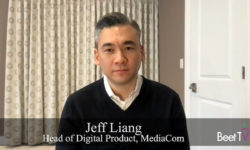The widespread usage of smartphones has provided an important source of data for healthcare marketers seeking to understand consumer behavior. That information underpins more personalized interactions with target audiences and ongoing relationships with key consumer groups.
“Customer data is incredibly valuable,” Melissa Gordon-Ring, executive vice president and managing director of Publicis Groupe’s Starcom unit, said in this interview with Beet.TV. “Publicis continues to make significant investments in access to data because we know it’s the future. When people raise their hand and give you their information, they’re almost signing a contract with you.”
First-party data have become more vital to advertisers as they prepare for the continued loss of audience tracking technologies like third-party cookies in web browsers and identifiers on some connected devices. In the healthcare industry, the Health Insurance Portability and Accountability Act of 1996 (HIPAA) sets rules on how some healthcare data can be shared.
“We utilize that to have as much of a direct dialog as possible when he have access to that data,” Gordon-Ring said. “Obviously, there are certain restrictions in the healthcare space, but across the board, in essence, it also allows for a better advertising and content and communications strategy. If you know a little bit more about the person you’re speaking to, you can ideally have a more relevant dialog.”
Data Insights
Engagement metrics also provide key insights into how consumers behave, including their visits to websites, interactions and keyword searches. The data also help to understand people’s medical conditions and whether they’re seeking treatment from healthcare providers.
“We want all of the data — the more, the better. Unless you can really action on it, it’s just a number,” she said. “For us, it’s also about understanding how long many of these people have been suffering from a certain disease.”
The private nature of people’s health also requires a delicate touch.
“Always be sensitive. Be sensitive that you may be communicating to someone who is not open to sharing information about themselves or something they may be dealing with, in regards to their health,” Gordon-Ring said. “We want to talk to our consumers as real people, and not just a patient.”
Telemedicine, CTV and Addressable Advertising
The pandemic led many healthcare providers to adopt the latest communications technologies to stay in touch with patients who were prevented from seeking medical attention except in the case of emergencies. Gordon-Ring sees more opportunities in video calls between patients and providers.
“The entire evolution of the telemedicine space as a function of Covid restrictions and people not being able to go into the doctor’s office,” she said. “We’ve seen a huge behavioral shift in terms of comfort in having a video dialog with a physician or nurse.”
As more people hook up their TVs to the internet and addressable advertising becomes more feasible, even among national broadcasters, healthcare marketers will have more ways to gain insights into consumer behaviors.
“My hope is that we can learn as much information through addressable that helps us better identify households with a greater prominence of a certain disease state, as well as help them manage their treatment through an ongoing dialog,” Gordon-Ring said.
You are watching “Data: Powering CTV for Marketers,” a Beet.TV leadership series presented by Sabio. For more videos, please visit this page.



































